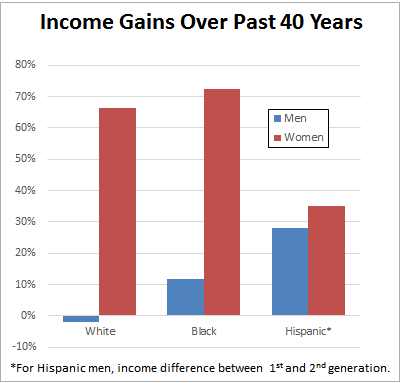 I don’t have any special news hook for this chart, but it’s been in the back of my mind for a while. Roughly speaking, it’s an answer to why white men are so angry about the economy even though they generally earn more than any other gender or ethnic group.
I don’t have any special news hook for this chart, but it’s been in the back of my mind for a while. Roughly speaking, it’s an answer to why white men are so angry about the economy even though they generally earn more than any other gender or ethnic group.
It’s all about progress. Women may earn 79 percent of what men earn, but over the past 40 years their incomes have increased rapidly. Black and Hispanic men haven’t done quite as well, but they’ve still made progress—and most people are relatively happy as long as things are getting better over time. The only group that has stagnated for four straight decades is white men. That’s plenty all by itself to make them angry, but it’s even worse when they watch literally everyone else doing better at the same time.
Don’t get me wrong: the “angry white guy” syndrome has plenty of sexist and racist overtones too. After all, white men used to be at the top of the gender/race heap, and now they aren’t. They don’t get to feel superior to women or blacks or Hispanics anymore, and their incomes have gone nowhere for four decades. Rightly or wrongly, you’d be mad too if this described you.
POSTSCRIPT: One reason I haven’t posted this before is because the data is hard to get. It’s easy for most groups—the Census data works fine—but for Hispanics the Census data is heavily skewed by the very low incomes of illegal immigrants, who have increased over time. As a proxy for income gains among Hispanic men who were born in America (to match the demographics of the other groups) I’ve used Pew’s estimate of the income difference between 1st and 2nd generation Hispanics. Obviously this is far from ideal, but I’m not aware of a clean source of comparable data for all this.
ALSO: Asian men and women have also seen substantial income gains over the past 40 years, but the Census figures for Asians don’t go back that far. That’s why they aren’t included in the chart.


















